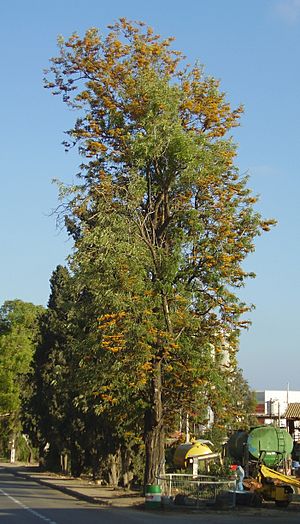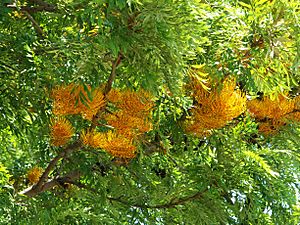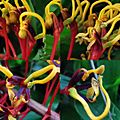Silky oak facts for kids
Quick facts for kids Silky oak |
|
|---|---|
 |
|
| Grevillea robusta at Gan Shmuel, Israel | |
| Scientific classification | |
| Genus: |
Grevillea
|
| Species: |
robusta
|
The Silky Oak (scientific name: Grevillea robusta) is a tall flowering tree. It is also known by names like southern silky oak or silver oak. This tree belongs to the plant family called Proteaceae.
Even though it's called an "oak," it's not a true oak tree like the ones you might know. The Silky Oak is the biggest species in its group, or genus, called Grevillea. It originally comes from the eastern coast of Australia. You can find it growing naturally near rivers, in warm, humid areas, and in dry rainforests.
Contents
What the Silky Oak Looks Like
The Silky Oak is a tree that grows very quickly. It is an evergreen tree, meaning it keeps its leaves all year round. It usually has one main trunk and can grow to be about 5 to 40 meters (about 16 to 130 feet) tall.
Tree Bark and Leaves
The bark of the Silky Oak is dark grey and has deep grooves. Its leaves look a bit like ferns. They are usually 10 to 34 centimeters (about 4 to 13 inches) long and 9 to 15 centimeters (about 3.5 to 6 inches) wide. Each leaf is divided into many smaller parts, sometimes up to 31 lobes. These lobes can be further divided. The tree often loses many of its leaves just before it flowers.
Silky Oak Flowers and Fruit
The flowers of the Silky Oak grow in special groups that look like a "toothbrush." These groups are usually 12 to 15 centimeters (about 5 to 6 inches) long. The flowers are smooth and mostly yellowish-orange, but sometimes they can be reddish.
The female part of each flower has a stalk that is about 21 to 28 millimeters (about 0.8 to 1.1 inches) long. The tree flowers from September to November. After flowering, it produces a smooth fruit called a follicle.
Naming the Silky Oak
The Silky Oak, Grevillea robusta, was first officially described in 1830. This was done by a botanist named Robert Brown. He used notes from another botanist, Allan Cunningham. Cunningham had collected a sample of the tree in 1827 near Moreton Bay.
The name robusta comes from a Latin word. It means "strong like oak" or "robust," which describes the tree's sturdy nature.
Where the Silky Oak Grows
The Silky Oak naturally grows along the coast and mountain ranges in southern Queensland and in New South Wales, Australia. It grows in warm rainforests and wet forests. Today, it is quite rare in its original natural areas.
However, the tree has been planted in many other places around the world. This includes Norfolk Island, Lord Howe Island, South Africa, New Zealand, Hawaii, and Florida. In some of these places, like parts of New South Wales, Victoria, Hawaii, and South Africa, it has grown so much that it is considered a weed or an "invader." This means it can sometimes take over areas where other plants grow.
How People Use Silky Oak Wood
For a long time, before aluminium became common, the wood from the Silky Oak was very popular. People used it to make window frames because it is strong and resists wood rot. It was also used to make furniture, cabinets, and fences.
Because there are fewer Silky Oak trees in the wild now, cutting them down for wood has become limited. Recently, some guitar makers, like Larrivée, have started using Silky Oak wood for parts of their guitars. They like its sound and how it looks.
Growing Silky Oak Trees
When they are young, Silky Oak trees can be grown indoors as houseplants. They can handle a bit of shade, but they prefer lots of sun. This is because they grow best in warm places. If you plant a young tree outside, it needs protection from frost, especially on cold nights.
Once the tree is older and settled, it becomes much tougher. It can handle temperatures as low as -8 degrees Celsius (about 18 degrees Fahrenheit). It doesn't need a lot of water and can survive fairly dry conditions. However, if you plant it near natural bushland, you need to be careful. It can spread easily and become an invasive plant.
Silky Oak trees are also often used as a base for grafting other types of grevilleas that are harder to grow. In the city of Kunming in China, many Silky Oak trees have been planted to create shady streets. In South Africa, they are grown on large farms and can even be planted alongside maize (corn) in special farming systems.
In the UK, the Silky Oak has received an important award called the Royal Horticultural Society's Award of Garden Merit. This award means it is a great plant for gardens.
Safety Information: Toxicity
It's important to know that the flowers and fruit of the Silky Oak contain a substance called hydrogen cyanide, which can be harmful. Also, a chemical in the tree called tridecylresorcinol can cause a skin rash if you touch it.
Images for kids
See also
 In Spanish: Grevillea robusta para niños
In Spanish: Grevillea robusta para niños
















